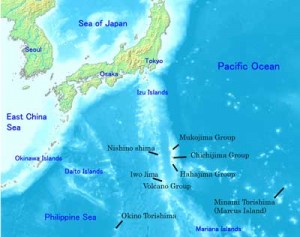
Location of the Ogasawara Islands.
Source: Wikimedia Commons
Islands are complex ecological objects produced through flows of flora, coral polyps, human migration, and global capital. They are places that are constantly being changed through human and non-human action. Therefore, they are wonderfully rich sites for environmental historians, not to mention cultural, economic, and historians of science, to examine. They are less miniature worlds than they are places made by the convergence of worlds. In this podcast Colin Tyner, a PhD candidate at the University of California, Santa Cruz, examines the Ogasawara Islands group and it environmental histories.
The Ogasawara Islands are situated one thousand kilometres south of Tokyo in the Pacific Ocean. They were first settled in the 19th century and went through distinct phases of exploitation, military use and nature conservation during this period reflecting changing attitudes to the natural world. Colin will illustrate how different social, cultural and natural worlds converged on the Ogasawara Islands.
Blogs mentioned
Colin Tyner, The Labour of Nature and Island Life
Place and Placelessness virtual workshop
Music credit
“Aerofonia” by Mario Mattioli
Available from ccMixter
Literature cited
Anderson, Jennifer, “Nature’s Currency: The Atlantic Mahogany Trade and the Commodification of Nature in the 18th Century”, Early American Studies, 2:1 (Spring 2004).
MacArthur, Robert H., Edward O. Wilson, The Theory of Island Biogeography (Princeton, N.J.: Princeton University Press, 1967).
Ponting, Clive, A green history of the world (London: Penguin, 1991).


Recent Comments